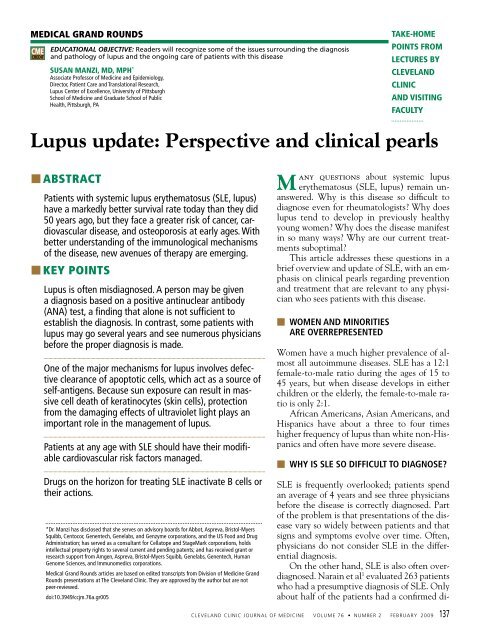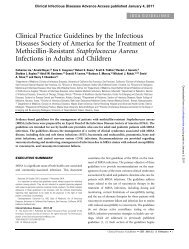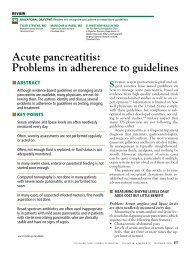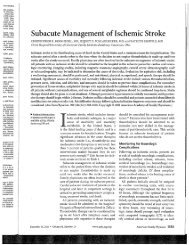Lupus update - Cleveland Clinic Journal of Medicine
Lupus update - Cleveland Clinic Journal of Medicine
Lupus update - Cleveland Clinic Journal of Medicine
You also want an ePaper? Increase the reach of your titles
YUMPU automatically turns print PDFs into web optimized ePapers that Google loves.
MEDICAL GRAND ROUNDS<br />
CME<br />
CREDIT<br />
EDUCATIONAL OBJECTIVE: Readers will recognize some <strong>of</strong> the issues surrounding the diagnosis<br />
and pathology <strong>of</strong> lupus and the ongoing care <strong>of</strong> patients with this disease<br />
SUSAN MANZI, MD, MPH *<br />
Associate Pr<strong>of</strong>essor <strong>of</strong> <strong>Medicine</strong> and Epidemiology,<br />
Director, Patient Care and Translational Research,<br />
<strong>Lupus</strong> Center <strong>of</strong> Excellence, University <strong>of</strong> Pittsburgh<br />
School <strong>of</strong> <strong>Medicine</strong> and Graduate School <strong>of</strong> Public<br />
Health, Pittsburgh, PA<br />
take-home<br />
points from<br />
lectures by<br />
cleveland<br />
clinic<br />
and visiting<br />
faculty<br />
<strong>Lupus</strong> <strong>update</strong>: Perspective and clinical pearls<br />
■■ABSTRACT<br />
Patients with systemic lupus erythematosus (SLE, lupus)<br />
have a markedly better survival rate today than they did<br />
50 years ago, but they face a greater risk <strong>of</strong> cancer, cardiovascular<br />
disease, and osteoporosis at early ages. With<br />
better understanding <strong>of</strong> the immunological mechanisms<br />
<strong>of</strong> the disease, new avenues <strong>of</strong> therapy are emerging.<br />
■■KEY POINTS<br />
<strong>Lupus</strong> is <strong>of</strong>ten misdiagnosed. A person may be given<br />
a diagnosis based on a positive antinuclear antibody<br />
(ANA) test, a finding that alone is not sufficient to<br />
establish the diagnosis. In contrast, some patients with<br />
lupus may go several years and see numerous physicians<br />
before the proper diagnosis is made.<br />
One <strong>of</strong> the major mechanisms for lupus involves defective<br />
clearance <strong>of</strong> apoptotic cells, which act as a source <strong>of</strong><br />
self-antigens. Because sun exposure can result in massive<br />
cell death <strong>of</strong> keratinocytes (skin cells), protection<br />
from the damaging effects <strong>of</strong> ultraviolet light plays an<br />
important role in the management <strong>of</strong> lupus.<br />
Patients at any age with SLE should have their modifiable<br />
cardiovascular risk factors managed.<br />
Drugs on the horizon for treating SLE inactivate B cells or<br />
their actions.<br />
*Dr. Manzi has disclosed that she serves on advisory boards for Abbot, Aspreva, Bristol-Myers<br />
Squibb, Centocor, Genentech, Genelabs, and Genzyme corporations, and the US Food and Drug<br />
Administration; has served as a consultant for Cellatope and StageMark corporations, holds<br />
intellectual property rights to several current and pending patents; and has received grant or<br />
research support from Amgen, Aspreva, Bristol-Myers Squibb, Genelabs, Genentech, Human<br />
Genome Sciences, and Immunomedics corporations.<br />
Medical Grand Rounds articles are based on edited transcripts from Division <strong>of</strong> <strong>Medicine</strong> Grand<br />
Rounds presentations at The <strong>Cleveland</strong> <strong>Clinic</strong>. They are approved by the author but are not<br />
peer-reviewed.<br />
doi:10.3949/ccjm.76a.gr005<br />
any questions about systemic lupus<br />
M erythematosus (SLE, lupus) remain unanswered.<br />
Why is this disease so difficult to<br />
diagnose even for rheumatologists? Why does<br />
lupus tend to develop in previously healthy<br />
young women? Why does the disease manifest<br />
in so many ways? Why are our current treatments<br />
suboptimal?<br />
This article addresses these questions in a<br />
brief overview and <strong>update</strong> <strong>of</strong> SLE, with an emphasis<br />
on clinical pearls regarding prevention<br />
and treatment that are relevant to any physician<br />
who sees patients with this disease.<br />
■■ WOMEN AND MINORITIES<br />
are overrepresented<br />
Women have a much higher prevalence <strong>of</strong> almost<br />
all autoimmune diseases. SLE has a 12:1<br />
female-to-male ratio during the ages <strong>of</strong> 15 to<br />
45 years, but when disease develops in either<br />
children or the elderly, the female-to-male ratio<br />
is only 2:1.<br />
African Americans, Asian Americans, and<br />
Hispanics have about a three to four times<br />
higher frequency <strong>of</strong> lupus than white non-Hispanics<br />
and <strong>of</strong>ten have more severe disease.<br />
■■ WHY IS SLE SO DIFFICULT TO DIAGNOSE?<br />
SLE is frequently overlooked; patients spend<br />
an average <strong>of</strong> 4 years and see three physicians<br />
before the disease is correctly diagnosed. Part<br />
<strong>of</strong> the problem is that presentations <strong>of</strong> the disease<br />
vary so widely between patients and that<br />
signs and symptoms evolve over time. Often,<br />
physicians do not consider SLE in the differential<br />
diagnosis.<br />
On the other hand, SLE is also <strong>of</strong>ten overdiagnosed.<br />
Narain et al 1 evaluated 263 patients<br />
who had a presumptive diagnosis <strong>of</strong> SLE. Only<br />
about half <strong>of</strong> the patients had a confirmed di-<br />
CLEVELAND CLINIC JOURNAL OF MEDICINE VOLUME 76 • NUMBER 2 FEBRUARY 2009 137
LUPUS<br />
Patients spend<br />
an average <strong>of</strong><br />
4 years and see<br />
three physicians<br />
before SLE is<br />
correctly<br />
diagnosed<br />
agnosis; about 5% had a different autoimmune<br />
disease, such as scleroderma, systemic sclerosis,<br />
Sjögren syndrome, or polymyositis; 5% had fibromyalgia;<br />
29% tested positive for ANA but<br />
did not have an autoimmune disease; and<br />
10% had a nonrheumatic disease, such as a<br />
hematologic malignancy with rheumatic disease<br />
manifestations. For patients referred by a<br />
community rheumatologist, the diagnostic accuracy<br />
was better, about 80%.<br />
The traditional classification criteria for<br />
SLE 2,3 are problematic. Some criteria are very<br />
specific for SLE but are not very sensitive—eg,<br />
anti-double-stranded DNA is present in about<br />
half <strong>of</strong> patients with SLE. Others tests, like<br />
ANA, are sensitive but not specific—although<br />
ANA is present in 95% <strong>of</strong> patients with SLE,<br />
the positive predictive value <strong>of</strong> the test for<br />
SLE for any given patient is only 11%.<br />
Other criteria are highly subjective, including<br />
oral ulcers and photosensitivity.<br />
These signs may be present in normal individuals<br />
who get an occasional aphthous ulcer<br />
or who are fair-skinned and burn easily with<br />
prolonged sun exposure. It takes a trained clinician<br />
to distinguish these from the photosensitivity<br />
and oral ulcers associated with lupus.<br />
Many diseases can mimic SLE<br />
Fibromyalgia frequently presents in women<br />
and may include joint and muscle aches,<br />
fatigue, and occasionally a positive ANA.<br />
ANA may be seen in about 15% <strong>of</strong> healthy<br />
women.<br />
Sjögren syndrome can also present with<br />
arthritis, fatigue, and a positive ANA; it is<br />
commonly overlooked because physicians do<br />
not <strong>of</strong>ten think to ask about the classic symptoms<br />
<strong>of</strong> dry eyes and dry mouth.<br />
Dermatomyositis causes rashes that have<br />
many features in common with SLE. Even<br />
the skin biopsy is <strong>of</strong>ten indistinguishable from<br />
SLE.<br />
Hematologic problems, such as idiopathic<br />
or thrombotic thrombocytopenic purpura, primary<br />
antiphospholipid syndrome, and hematologic<br />
neoplasms, can cause serologic changes,<br />
a positive ANA, and other manifestations<br />
seen in SLE.<br />
Drug-induced lupus should always be<br />
considered in older patients presenting with<br />
SLE-like disease. Now with the use <strong>of</strong> minocycline<br />
(Minocin) and other related agents for<br />
the treatment <strong>of</strong> acne, we are seeing younger<br />
women with drug-induced lupus.<br />
■■ PATIENTS ASK ‘WHY ME?’<br />
<strong>Lupus</strong> typically develops in a young woman<br />
who was previously healthy. Such patients inevitably<br />
wonder, why me?<br />
<strong>Lupus</strong> is like a puzzle, with genetics, gender,<br />
and the environment being important pieces<br />
<strong>of</strong> the puzzle. If all the pieces come together,<br />
people develop defective immune regulation<br />
and a break in self-tolerance. Everyone generates<br />
antibodies to self, but these low-affinity,<br />
nonpathologic antibodies are inconsequential.<br />
In SLE, autoantibodies lead to the formation<br />
<strong>of</strong> immune complexes, complement activation,<br />
and tissue damage.<br />
Genetics plays an important role<br />
Genetics plays an important role but is clearly<br />
not the only determining factor. Clustering in<br />
families has been shown, although a patient<br />
with lupus is more likely to have a relative<br />
with another autoimmune disease, especially<br />
autoimmune thyroid disease, than with SLE.<br />
The likelihood <strong>of</strong> an identical twin <strong>of</strong> a patient<br />
with SLE having the disease is only 25%<br />
to 30%, and is only about 5% for a fraternal<br />
twin.<br />
In the first few months <strong>of</strong> 2008, four major<br />
studies were published that shed light on the<br />
genetics <strong>of</strong> SLE. 4–7 Together, the studies evaluated<br />
more than 5,000 patients with SLE using<br />
genome-wide association scans and identified<br />
areas <strong>of</strong> the genome that are frequently different<br />
in patients with lupus than in healthy<br />
controls. Three <strong>of</strong> the four studies identified<br />
the same genetic area as important and supported<br />
the concept that B cells and complement<br />
activation play important roles in the<br />
disease pathogenesis.<br />
Although over 95% <strong>of</strong> cases <strong>of</strong> SLE cannot<br />
be attributed to a single gene, there are<br />
rare cases <strong>of</strong> lupus that may provide important<br />
clues to mechanisms <strong>of</strong> disease. For example a<br />
homozygous deficiency <strong>of</strong> C1q (an early component<br />
<strong>of</strong> complement) is extremely rare in<br />
lupus but is associated with the highest risk<br />
(nearly 90%) <strong>of</strong> developing the disease. Deficiencies<br />
in other components <strong>of</strong> the comple-<br />
138 CLEVELAND CLINIC JOURNAL OF MEDICINE VOLUME 76 • NUMBER 2 FEBRUARY 2009
manzi<br />
ment cascade also carry a high risk <strong>of</strong> disease<br />
development.<br />
Investigators discovered that C1q plays<br />
an important role in clearing away apoptotic<br />
cellular debris. If a person is deficient in C1q,<br />
clearance <strong>of</strong> this debris is impaired. In a person<br />
genetically predisposed to getting lupus,<br />
the immune system now has an opportunity to<br />
react to self-antigens exposed during apoptosis<br />
that are not being cleared away.<br />
Even though lupus cases cannot be explained<br />
by an absence <strong>of</strong> C1q, a defect in the<br />
clearance <strong>of</strong> apoptotic cells is a common, unifying<br />
feature <strong>of</strong> the disease.<br />
calculated the rate as five times higher than<br />
in the general population. The increased risk<br />
<strong>of</strong> osteoporosis is partly due to treatment with<br />
corticosteroids, but it is also likely caused by<br />
inflammation from lupus. Even controlling for<br />
steroid use, increased bone loss is still evident<br />
in patients with SLE.<br />
African American women with lupus are<br />
not exempt. Lee et al 9 found that, after adjusting<br />
for body mass, steroid use, thyroid disease,<br />
and menopausal status, African American<br />
women with SLE had more than five times the<br />
risk <strong>of</strong> low bone mineral density in the spine<br />
than white women with the disease.<br />
Immune response is enhanced<br />
by environmental factors<br />
Environmental factors, especially sun exposure,<br />
are also important. Following sunburn,<br />
skin cells undergo massive cell death, and patients<br />
with lupus have a huge release <strong>of</strong> selfantigens<br />
that can be recognized by the immune<br />
system. Sunburn is like having a booster<br />
vaccine <strong>of</strong> self-antigen to stimulate autoantibody<br />
production. Not only does the skin flare,<br />
but internal organs can also flare after intense<br />
sun exposure.<br />
■■ LUPUS SURVIVAL HAS IMPROVED;<br />
DISEASES OF AGING NOW A FOCUS<br />
In 1950, only 50% <strong>of</strong> patients with SLE survived<br />
5 years after diagnosis; now, thanks to<br />
better treatment and earlier diagnosis, 80% to<br />
90% survive at least 10 years.<br />
Early on, patients tend to die <strong>of</strong> active disease<br />
(manifestations <strong>of</strong> vasculitis, pulmonary<br />
hemorrhage, kidney problems) or infection.<br />
Over time, cardiovascular disease and osteoporosis<br />
become more <strong>of</strong> a problem. Patients also<br />
have a higher risk <strong>of</strong> cancer throughout life.<br />
<strong>Lupus</strong> has an unpredictable course, with<br />
flares and remissions. But underlying the reversible<br />
inflammatory changes is irreversible<br />
organ damage caused by the disease itself and,<br />
possibly, by treatment. Preventing bone disease,<br />
heart disease, and cancer now play more<br />
prominent roles in managing SLE.<br />
Increased bone disease<br />
Fracture rates are higher than expected in<br />
women with lupus; Ramsey-Goldman et al 8<br />
Increased cancer risk<br />
Patients with SLE have an increased risk <strong>of</strong><br />
hematologic cancer and possibly lung and hepatobiliary<br />
cancers.<br />
Bernatsky et al 10 evaluated cancer risk in<br />
an international cohort <strong>of</strong> patients with SLE<br />
from 23 sites. Among patients with SLE, for<br />
all cancers combined, the standardized incidence<br />
ratio was 1.2; for hematologic cancers<br />
the ratio was 2.8; and for non-Hodgkin lymphoma<br />
it was 2.4. Surprisingly, although SLE<br />
is primarily a disease <strong>of</strong> women, reproductive<br />
cancer rates in patients with SLE did not differ<br />
from background rates. Bernatsky et al did<br />
not compare rates <strong>of</strong> cervical cancer, as many<br />
cancer registries do not record it. However,<br />
studies from the National Institutes <strong>of</strong> Health<br />
indicate that cervical dysplasia is common in<br />
patients with lupus.<br />
Other interesting findings included an increased<br />
risk <strong>of</strong> hepatobiliary cancer, especially<br />
among men with SLE. Lung cancers were also<br />
increased, which has been observed in patients<br />
with other autoimmune diseases such<br />
as scleroderma and polymyositis. Smoking is<br />
a strong predictor for developing autoimmune<br />
conditions and may play a role in the observed<br />
increased cancer risk.<br />
Early and advanced cardiovascular disease<br />
Patients with SLE are at high risk <strong>of</strong> atherosclerotic<br />
cardiovascular disease. At the University<br />
<strong>of</strong> Pittsburgh Medical Center from<br />
1980 to 1993, we compared the incidence <strong>of</strong><br />
myocardial infarction in nearly 500 women<br />
with SLE and more than 2,000 women <strong>of</strong> similar<br />
age in the Framingham Offspring Study.<br />
Everyone<br />
generates<br />
antibodies to<br />
self, but these<br />
are normally<br />
ineffective<br />
CLEVELAND CLINIC JOURNAL OF MEDICINE VOLUME 76 • NUMBER 2 FEBRUARY 2009 139
LUPUS<br />
Sun exposure<br />
is like having<br />
a booster<br />
vaccine for<br />
autoimmunity<br />
At ages 15 to 24, women with lupus had a rate<br />
<strong>of</strong> 6.33 per 1,000 person-years; at age 25 to<br />
34, the rate was 3.66 per 1,000 person-years.<br />
None <strong>of</strong> the Framingham women in those age<br />
groups had events.<br />
Women ages 35 to 44 with lupus had a risk<br />
<strong>of</strong> heart attack 50 times higher than women in<br />
the Framingham cohort, and women in older<br />
age groups had a risk 2.5 to 4 times higher. 11<br />
Subclinical cardiovascular disease is also<br />
increased in women with SLE. Asanuma et<br />
al 12 used electron-beam computed tomography<br />
to screen for coronary artery calcification<br />
in 65 patients with SLE and 69 control<br />
subjects with no history <strong>of</strong> coronary artery<br />
disease matched for age, sex, and race. Calcification<br />
was present in 31% <strong>of</strong> patients with<br />
lupus vs 9% <strong>of</strong> controls (P = .002). Roman et<br />
al 13 performed carotid ultrasonography on 197<br />
patients with lupus and 197 matched controls<br />
and found more plaque in patients with lupus<br />
(37%) than in controls (15%, P < .001).<br />
Other data also suggest that women with<br />
lupus have advanced cardiovascular disease<br />
and develop it early, with most studies finding<br />
the greatest relative risk <strong>of</strong> cardiovascular<br />
disease between ages 18 and 45 years.<br />
Traditional risk factors for cardiovascular<br />
disease cannot fully explain the increased<br />
risk. Many patients with lupus have metabolic<br />
syndrome, hypertension, and renal disease,<br />
but even after adjusting for these risk factors,<br />
patients with lupus still have about a 7 to 10<br />
times higher risk <strong>of</strong> nonfatal coronary heart<br />
disease and a 17 times higher risk <strong>of</strong> fatal coronary<br />
heart disease. 14<br />
Many investigators are now exploring the<br />
role <strong>of</strong> immune dysfunction and inflammation<br />
in cardiovascular disease. A number <strong>of</strong> biomarkers<br />
have been proposed for predicting risk<br />
<strong>of</strong> cardiovascular disease in the general population.<br />
The list includes many inflammatory factors<br />
that rheumatologists have been studying for<br />
decades, including myeloperoxidase, autoantibodies,<br />
inflammatory cytokines, tumor necrosis<br />
factor alpha, and adhesion molecules, many <strong>of</strong><br />
which also play a role in autoimmunity.<br />
In our patients with SLE, we found that<br />
about 90% had three or more modifiable cardiovascular<br />
risk factors that were not being<br />
addressed appropriately (unpublished data).<br />
Lipid management was the least <strong>of</strong>ten addressed<br />
by rheumatologists and primary caregivers.<br />
There is reason to believe that lupus patients<br />
are a high-risk group that merit aggressive<br />
risk-factor management, but no formal<br />
recommendations can be made without clear<br />
evidence that this approach improves outcomes.<br />
■■ SLE increases the risk<br />
<strong>of</strong> adverse PREGNANCY outcomes<br />
Women with SLE more commonly miscarry<br />
and deliver low-birth-weight babies than do<br />
other women. A history <strong>of</strong> renal disease is the<br />
factor most predictive <strong>of</strong> poor pregnancy outcome,<br />
and the presence <strong>of</strong> certain autoantibodies<br />
increases the risk <strong>of</strong> neonatal lupus.<br />
We recommend that women with lupus<br />
have inactive disease for at least 6 months before<br />
becoming pregnant.<br />
■■ ORAL CONTRACEPTIVES<br />
AND HORMONE REPLACEMENT<br />
Hormone replacement therapy and oral contraceptives<br />
do not increase the risk <strong>of</strong> significant<br />
disease activity flares in lupus. However,<br />
women with lupus have an increased risk <strong>of</strong><br />
cardiovascular disease and thrombosis.<br />
Buyon et al 15 randomly assigned 351 menopausal<br />
women with inactive or stable active<br />
SLE to receive either hormone replacement<br />
therapy or placebo for 12 months. No significant<br />
increase in severe flares <strong>of</strong> the disease was<br />
observed, although the treatment group had a<br />
mild increase in minor flares.<br />
Petri et al 16 randomly assigned 183 women<br />
with inactive or stable active SLE to receive<br />
either combined oral contraceptives or placebo<br />
for 12 months and found similar rates <strong>of</strong><br />
disease activity between the two groups.<br />
A weakness <strong>of</strong> these trials is that women<br />
with antiphospholipid antibodies in high titers<br />
or who had previous thrombotic events<br />
were excluded.<br />
■■ TREATMENTS ON THE HORIZON?<br />
In the past 50 years, only three drug treatments<br />
have been approved for lupus: corticosteroids,<br />
hydroxychloroquine, and aspirin. Fortunately,<br />
140 CLEVELAND CLINIC JOURNAL OF MEDICINE VOLUME 76 • NUMBER 2 FEBRUARY 2009
manzi<br />
research in autoimmune diseases has rapidly expanded,<br />
and new drugs are on the horizon.<br />
Mycophenolate m<strong>of</strong>etil (CellCept) may be<br />
a reasonable alternative to cyclophos phamide<br />
(Cytoxan) for lupus nephritis and may be appropriate<br />
as maintenance therapy after induction<br />
with cyclophosphamide.<br />
Ginzler et al, 17 in a randomized, open-label<br />
trial in 140 patients with active lupus nephritis,<br />
gave either oral mycophenolate m<strong>of</strong>etil<br />
(initial dosage 1,000 mg/day, increased to<br />
3,000 mg/day) or monthly intravenous cyclophosphamide<br />
(0.5 g/m 2 , increased to 1.0 g/m 2 ).<br />
Mycophenolate m<strong>of</strong>etil was more effective in<br />
inducing remission than cyclophosphamide<br />
and had a better safety pr<strong>of</strong>ile.<br />
The Aspreva <strong>Lupus</strong> Management Study<br />
was designed to assess the efficacy <strong>of</strong> oral<br />
mycophenolate m<strong>of</strong>etil compared with intravenous<br />
cyclophosphamide in the initial<br />
treatment <strong>of</strong> patients with active class III–V<br />
lupus nephritis and to assess the long-term<br />
efficacy <strong>of</strong> mycophenolate m<strong>of</strong>etil compared<br />
with azathioprine in maintaining remission<br />
and renal function. It was the largest study <strong>of</strong><br />
mycophenolate m<strong>of</strong>etil in lupus nephritis to<br />
date. There were 370 patients with SLE enrolled.<br />
In the 24-week induction phase, patients<br />
were randomized to receive open-label<br />
mycophenolate m<strong>of</strong>etil with a target dose <strong>of</strong><br />
3 g/day or intravenous cyclophosphamide 0.5<br />
to 1.0 g/m 2 in monthly pulses. Both groups<br />
received prednisone. Response to treatment<br />
was defined as a decrease in proteinuria (as<br />
measured by the urinary protein-creatinine<br />
ratio) and improvement or stabilization in<br />
serum creatinine.<br />
The results (presented at the American<br />
College <strong>of</strong> Rheumatology Meeting, November<br />
6–11, 2007, in Boston, MA) showed that 104<br />
(56%) <strong>of</strong> the 185 patients treated with mycophenolate<br />
m<strong>of</strong>etil responded, compared with<br />
98 (53%) <strong>of</strong> the 185 patients treated with<br />
intravenous cyclophosphamide (P = .575).<br />
The study therefore did not meet its primary<br />
objective <strong>of</strong> showing a superior response rate<br />
with mycophenolate m<strong>of</strong>etil compared with<br />
cyclophosphamide. There was no difference<br />
in adverse events. It is this author’s opinion<br />
that having an agent that is at least as good as<br />
cyclphosphamide in treating lupus nephritis is<br />
a major step forward.<br />
Mycophenolate m<strong>of</strong>etil can cause fetal<br />
harm and should not be used during pregnancy.<br />
It is recommended that the drug be stopped<br />
for 3 to 6 months before a woman tries to conceive.<br />
New drugs target B cells<br />
Many new drugs for lupus target B cells.<br />
Rituximab (Rituxan) is a monoclonal antibody<br />
that depletes B cells by targeting the B-<br />
cell-specific antigen CD20. It has been studied<br />
for treating lupus in several open-label studies<br />
that altogether have included more than 400<br />
patients. 18–21 Regimens included either those<br />
used in oncology for treatment <strong>of</strong> lymphoma<br />
or those used in rheumatoid arthritis, coupled<br />
with high-dose corticosteroids and cyclophosphamide.<br />
In early studies, nearly 80% <strong>of</strong> treated<br />
patients entered at least partial remission,<br />
and 25% to 50% are still in remission more<br />
than 12 months later.<br />
The first randomized controlled trial <strong>of</strong><br />
rituximab vs placebo was recently completed<br />
and presented at the American College <strong>of</strong><br />
Rheumatology meeting, October 24–28, 2008,<br />
in Boston, MA. The EXPLORER trial (sponsored<br />
by Genentech) included 257 patients<br />
with moderate to severe disease activity. The<br />
results showed that there was no difference in<br />
major or partial clinical response (based on a<br />
change in the British Isles <strong>Lupus</strong> Assessment<br />
Group index) in those on rituximab (28.4%)<br />
vs placebo (29.6%) at 12 months (P = .97).<br />
Overall, adverse events were balanced between<br />
the groups. It is this author’s opinion<br />
that the bar for “response” was set very high<br />
in this study, considering that all patients who<br />
entered were fairly sick and received significant<br />
doses <strong>of</strong> corticosteroids that were tapered<br />
over the course <strong>of</strong> the trial.<br />
B-cell toleragens, which render B cells<br />
incapable <strong>of</strong> presenting specific antigens, are<br />
also <strong>of</strong> interest.<br />
Other experimental drugs target the soluble<br />
cytokine BLyS, which normally binds to<br />
a B-cell receptor and prolongs B-cell survival.<br />
It may also be possible to inhibit costimulatory<br />
pathways (which are normally important<br />
for inducing activation, proliferation,<br />
and class-switching <strong>of</strong> B cells) with the use <strong>of</strong><br />
cytotoxic T-lymphocyte-associated antigen 4<br />
immunoglobulin inhibitor (CTLA4Ig) and<br />
Up to 90%<br />
<strong>of</strong> patients<br />
survive at least<br />
10 years after<br />
diagnosis <strong>of</strong><br />
SLE<br />
CLEVELAND CLINIC JOURNAL OF MEDICINE VOLUME 76 • NUMBER 2 FEBRUARY 2009 141
LUPUS<br />
anti-CD40 ligand.<br />
The results <strong>of</strong> a 12-month exploratory,<br />
phase II trial <strong>of</strong> abatacept (Bristol-Myers<br />
Squibb) in patients with SLE and active<br />
poly arthritis, serositis, or discoid lesions were<br />
presented at the American College <strong>of</strong> Rheumatology<br />
meeting in 2008. The primary and<br />
secondary end points (based on an adjudicated<br />
British Isles <strong>Lupus</strong> Assessment Group<br />
index) were not met. There were no differences<br />
in adverse events. Post hoc analyses<br />
<strong>of</strong> other clinical end points and biomarkers<br />
suggested that abatacept may have benefit in<br />
lupus. Further studies are under way.<br />
Downstream blockade may also be useful,<br />
with drugs that inhibit inflammatory cytokines,<br />
particularly interferon alfa. This is<br />
now being tested in clinical trials. ■<br />
■■ REFERENCES<br />
1. Narain S, Richards HB, Satoh M, et al. Diagnostic accuracy for lupus<br />
and other systemic autoimmune diseases in the community setting.<br />
Arch Intern Med 2004; 164:2435–2441.<br />
2. Tan EM, Cohen AS, Fries JF, et al. The 1982 revised criteria for the<br />
classification <strong>of</strong> systemic lupus erythematosus. Arthritis Rheum<br />
1982;25:1271–1277.<br />
3. Hochberg, MC. Updating the American College <strong>of</strong> Rheumatology<br />
revised criteria for the classification <strong>of</strong> systemic lupus erythematosus<br />
[letter]. Arthritis Rheum 1997; 40:1725.<br />
4. Hom G, Graham RR, Modrek B, et al. Association <strong>of</strong> systemic lupus<br />
erythematosus with C8orf13 BLK and ITGAM ITGAX. N Engl J Med<br />
2008; 358:900–909.<br />
5. Kozyrev SV, Abelson AK, Wojcik J, et al. Functional variants in the B<br />
cell gene BANK1 are associated with systemic lupus erythematosus.<br />
Nat Genet 2008; 40:211–216.<br />
6. International Consortium for Systemic <strong>Lupus</strong> Erythematosus<br />
Genetics (SLEGEN), Harley JB, Alarcón-Riquelme ME, Criswell LA,<br />
et al. Genome-wide association scan in women with systemic lupus<br />
erythematosus identifies susceptibility variants in ITGAM, PXK,<br />
KIAA1542 and other loci. Nat Genet 2008; 40:204–210.<br />
7. Nath SK, Han S, Kim Howard X, et al. A nonsynonymous functional<br />
variant in integrin alpha(M) (encoded by ITGAM) is associated with<br />
systemic lupus erythematosus. Nat Genet 2008; 40:152–154.<br />
8. Ramsey-Goldman R, Dunn JE, Huang CF, et al. Frequency <strong>of</strong><br />
fractures in women with systemic lupus erythematosus: comparison<br />
with United States population data. Arthritis Rheum 1999;<br />
42:882–890.<br />
9. Lee C, Almagor O, Dunlop DD, et al. Association between<br />
African-American race/ethnicity and low bone mineral density in<br />
women with systemic lupus erythematosus. Arthritis Rheum 2007;<br />
57:585–592.<br />
10. Bernatsky S, Boivin JF, Joseph L, et al. An international cohort<br />
study <strong>of</strong> cancer in systemic lupus erythematosus. Arthritis Rheum<br />
2005; 52:1481-1490.<br />
11. Manzi S, Meilahn EN, Rairie JE, et al. Age-specific incidence rates<br />
<strong>of</strong> myocardial infarction and angina in women with systemic lupus<br />
erythematosus: comparison with the Framingham Study. Am J<br />
Epidemiol 1997; 145:408–415.<br />
12. Asanuma Y, Oeser A, Shintani AK, et al. Premature coronary artery<br />
atherosclerosis in systemic lupus erythematosus. N Engl J Med<br />
2003; 349:2407–2415.<br />
13. Roman MJ, Shanker BA, Davis A, et al. Prevalence and correlates<br />
<strong>of</strong> accelerated atherosclerosis in systemic lupus erythematosus. N<br />
Engl J Med 2003; 349:2399–2406. Erratum in: N Engl J Med 2006;<br />
355:1746.<br />
14. Esdaile JM, Abrahamowicz M, Grodzicky T, et al. Traditional<br />
Framingham risk factors fail to fully account for accelerated atherosclerosis<br />
in systemic lupus erythematosus. Arthritis Rheum 2001;<br />
44:2331–2337.<br />
15. Buyon JP, Petri MA, Kim MY, et al. The effect <strong>of</strong> combined estrogen<br />
and progesterone hormone replacement therapy on disease activity<br />
in systemic lupus erythematosus: a randomized trial. Ann Intern<br />
Med 2005; 142:953–962.<br />
16. Petri M, Kim MY, Kalunian KC, et al; OC SELENA Trial. Combined<br />
oral contraceptives in women with systemic lupus erythematosus. N<br />
Engl J Med 2005; 353:2550–2558.<br />
17. Ginzler EM, Dooley MA, Aranow C, et al. Mycophenolate m<strong>of</strong>etil<br />
or intravenous cyclophosphamide for lupus nephritis. N Engl J Med<br />
2005; 353:2219–2228.<br />
18. Anolik JH, Barnard J, Cappione A, et al. Rituximab improves peripheral<br />
B cell abnormalities in human systemic lupus erythematosus.<br />
Arthritis Rheum 2004; 50:3580–3590.<br />
19. Looney RJ, Anolik JH, Campbell D, et al. B cell depletion as a novel<br />
treatment for systemic lupus erythematosus: a phase I/II dose escalation<br />
trial <strong>of</strong> rituximab. Arthritis Rheum 2004; 50:2580–2589.<br />
20. Leandro MJ, Edwards JC, Cambridge G, Ehrenstein MR, Isenberg<br />
DA. An open study <strong>of</strong> B lymphocyte depletion in systemic lupus<br />
erythematosus. Arthritis Rheum 2002; 46:2673–2677.<br />
21. Cambridge G, Stohl W, Leandro MJ, Migone TS, Hilbert DM, Edwards<br />
JC. Circulating levels <strong>of</strong> B lymphocyte stimulator in patients<br />
with rheumatoid arthritis following rituximab treatment: relationships<br />
with B cell depletion, circulating antibodies, and clinical<br />
relapse. Arthritis Rheum 2006; 54:723–732.<br />
ADDRESS: Susan Manzi, MD, MPH, University <strong>of</strong> Pittsburgh Arthritis Institute,<br />
Biomedical Science Tower, South Wing, Room 722, 3500 Terrace<br />
Street, University <strong>of</strong> Pittsburgh, Pittsburgh, PA 15261; e-mail sxm6+@<br />
pitt.edu.<br />
CME<br />
Credit<br />
Test<br />
Category I CME Credit<br />
Test your knowledge<br />
<strong>of</strong> clinical topics<br />
Visit WWW.CCJM.ORG<br />
142 CLEVELAND CLINIC JOURNAL OF MEDICINE VOLUME 76 • NUMBER 2 FEBRUARY 2009











